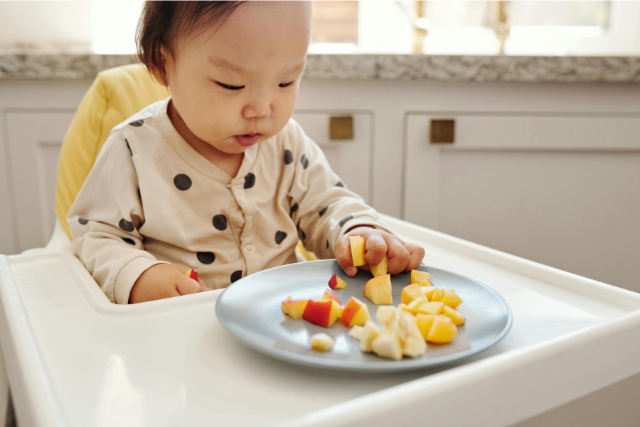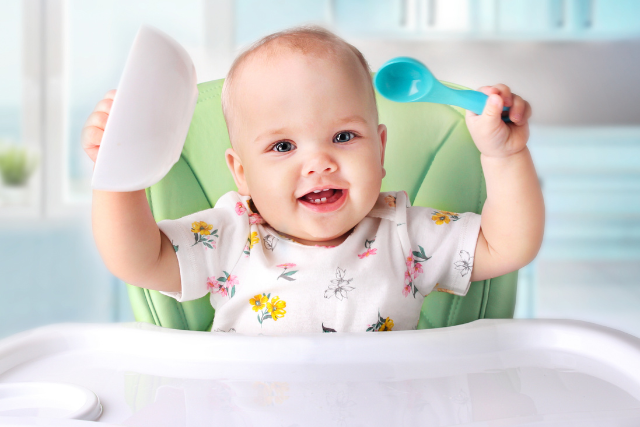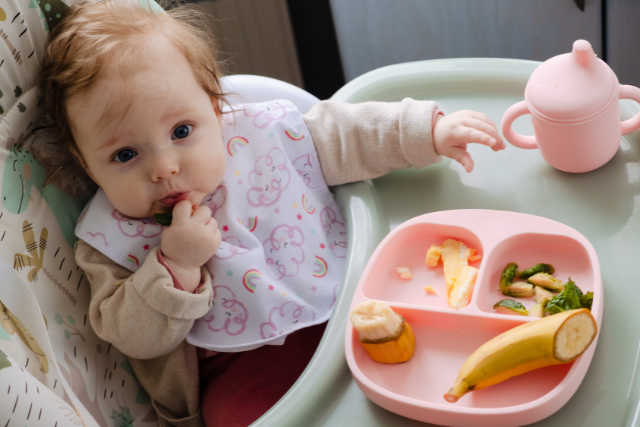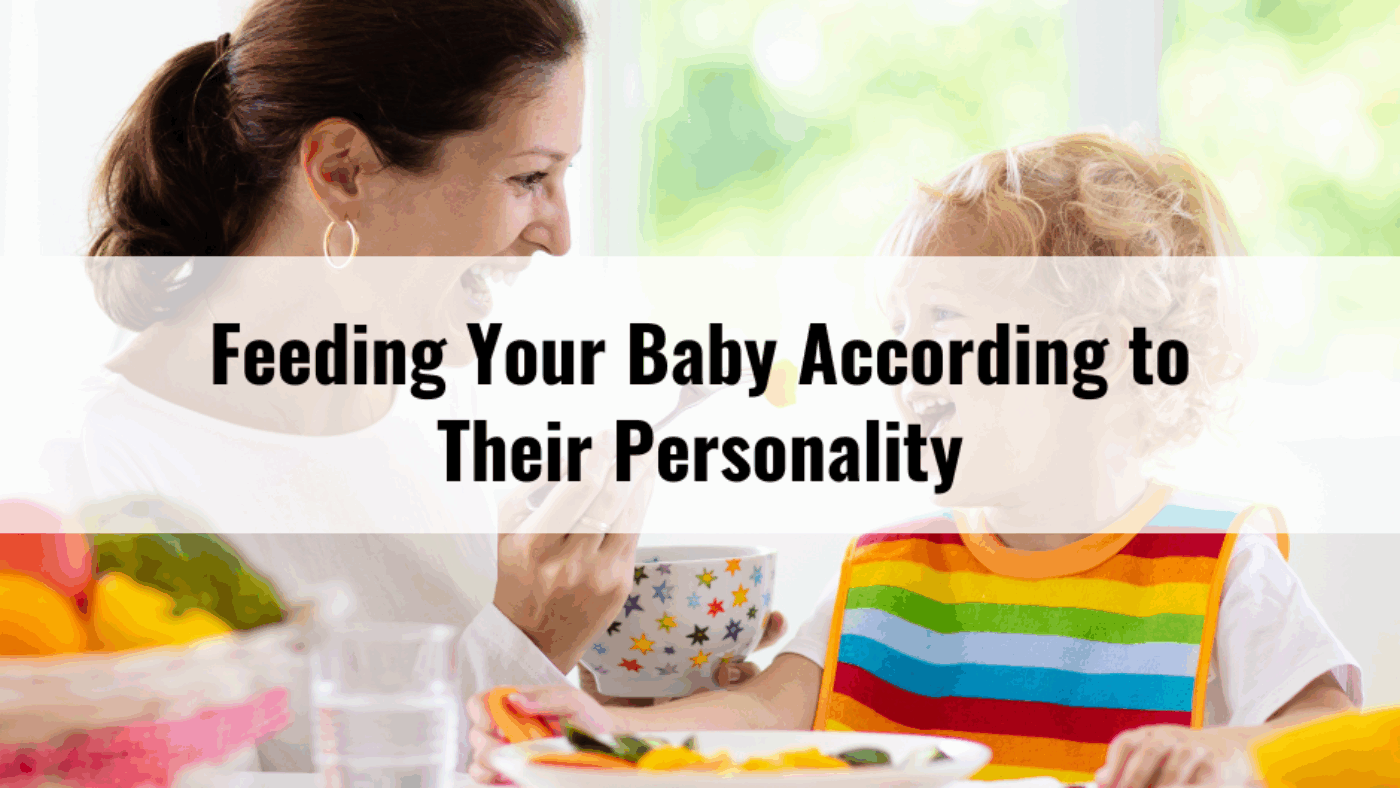Babies may be small, but their personalities can be really big and often show up the most at mealtimes! If you’ve ever wondered why your baby is so different from your friend’s baby, or even from your older child, you’re not alone. Personality-based baby feeding can help you understand how temperament affects mealtime behaviors and guide you in creating an approach that works for your little one.
As both a dietitian and a mom, I know firsthand that feeding isn’t just about offering nutritious food, it’s about understanding who you’re feeding. And that means paying attention to your baby’s temperament.
Let’s talk about what that means and how you can support your baby’s eating journey in a way that suits their unique little self.
WHAT IS TEMPERAMENT IN PERSONALITY-BASED BABY FEEDING?

Temperament is basically your baby’s natural way of reacting to the world. Some babies are calm and slow-to-warm-up, while others are intense and energetic from day one. These traits are believed to be inborn and tend to stay quite stable as your child grows, though they can shift a bit with experience and support.
And guess what? You also have a temperament! Sometimes your style matches well with your baby’s, and sometimes it feels like you’re speaking two different languages. That’s okay. The key is to be aware of it.
When it comes to personality-based baby feeding, understanding temperament can help reduce stress, increase connection, and make mealtimes more enjoyable. Recognizing your baby’s temperament allows you to shape personality-based baby feeding strategies to suit their unique needs. Let’s check out!
7 TEMPERAMENT TRAITS AND HOW THEY AFFECT FEEDING
Here are some common temperament dimensions that can show up during mealtimes and some practical, gentle tips for each.
1. Activity Level: The Wigglers vs. The Watchers
Some babies are super chill—they’re happy to sit with a few toys, quietly play, and observe the world around them. Then there are the babies who seem to be born moving! Even before they can crawl, they’re already twisting, rolling, and trying to explore everything.

If your baby is more of a “watcher,” they may enjoy sitting in the high chair, slowly exploring new foods with their hands or fingers. Mealtimes with them can feel more calm and focused.

But if you’ve got a little “wiggler” who can’t sit still, you’re not alone! These babies may not enjoy long meals in the high chair and might get bored or fussy quickly. For them, it often helps to offer smaller meals or snacks more frequently throughout the day.
Tip: Don’t stress if your active baby doesn’t want to sit for long. Let them explore food in short bursts and keep mealtimes fun, not forced.
Every baby has their own rhythm, some eat slow and steady, some like to grab a bite and go. Both are okay!
2. Biological Rhythmicity: The Clock Baby vs. The Go-with-the-Flow Baby

Have you noticed that your baby gets sleepy, hungry, or cranky at the same time every day? That could mean your little one has a strong internal rhythm, which is a natural body clock that runs like clockwork. Some babies nap and poop on schedule, while others are more unpredictable. You just never know when they’ll be hungry or ready to sleep.
For babies with a regular rhythm, sticking to a consistent schedule for meals and naps can really help. They feel more secure knowing when food is coming. You’ll probably find it easier to plan your day too, such as fitting in a quick lunch or grocery run during nap time!
But if your baby is more flexible or random in their cues, it’s okay to take a more laid-back approach. Follow their hunger signs, maybe they’re not hungry at the usual 12pm lunch, but ready to eat again at 1:30pm instead. Go with the flow.
Tip: In many Malaysian homes, meals tend to follow routines naturally, like bath after meal. These gentle patterns can help build a sense of rhythm too.
And yes, juggling naps, milk, solids, and everything else can get overwhelming. If you’re not sure where to start, it’s okay to try out a simple schedule and adjust from there. Your baby will guide you.
3. Distractibility
Some babies can sit and focus on their food; others get distracted by everything. A small sound, a passing cat, or even the shadow on the wall can pull their attention away from the plate in front of them.
This is called distractibility, and just like adults, some babies can tune things out better than others. For babies who are still learning how to chew and swallow safely, distractions can make things a bit trickier (and sometimes a little messy).

To help your baby stay focused during mealtimes, try to reduce distractions as much as you can. Turn off the TV, put away toys, and maybe let the pets chill in another room for a while.
Tip: If your baby’s high chair is near their play area, try throwing a thin cloth to cover the toys. Out of sight, out of mind!
A calm, simple eating environment helps your baby focus on tasting, chewing, and learning all about food. And for babies who get distracted super easily, keeping things quiet and predictable can make a big difference.
4. Approach vs. Withdrawal
Some babies jump straight into new things without blinking; others prefer to take their time, slowly warm up, and observe first before trying anything new.

Starting solids is definitely one of those big new things! And just like adults, babies respond differently. Some are super excited to eat, while others need time to get used to new tastes, smells, and textures.
Here’s how I often see it play out:
-
The Observers: These babies are the slow starters. They might frown, poke at the food, or just stare at it for a while. This is normal! Give them time to explore and don’t rush them. Let them touch, smell, and get familiar first. In our culture, sometimes the pressure from excited grandparents “Eh, you don’t like it?” can make us feel worried, but trust your baby’s pace.
-
The Eager Eater: These babies are ready to eat from day one! They open their mouths wide, reach for food, and don’t seem fussy at all. You might find yourself saying, “Wah, you like everything?!”
-
The In-Between Baby: Most babies are somewhere in the middle. Maybe they love banana the first time but need a few tries to enjoy carrot or tofu. That’s okay! Exposure and patience are key.
Tip: Whether your baby is a little hesitant or very adventurous, follow their lead. Try not to compare with other babies—every child learns in their own way and time. Some babies need 10–15 exposures before they accept something new. That baby who rejected porridge on day 1 might love it by day 10.
5. Adaptability: Go-with-the-flow or Needs Time to Adjust?
Adaptability is about how easily your baby or toddler can handle changes, especially when switching from one activity to another. For example, going from playtime to mealtime, or leaving the playground when it’s time to go home.
6. Attention Span & Persistence: Focused or Frustrated Easily
Some babies stay focused and keep trying, even when something is difficult. Others may lose interest quickly or give up if things don’t go smoothly.
This is where persistence comes in. It’s a great quality (even if it sometimes feels like “stubbornness” to us parents!).

For example, a very persistent baby might insist on feeding herself. She wants to hold the spoon, grab the food, and do it all on her own—even if most of it ends up on the floor! It can be messy and tiring, but this determination is actually a good thing. She’s learning through practice.

On the other hand, a less persistent baby may give up easily. If self-feeding feels too hard, she might just push the food away or wait for you to feed her instead. That’s okay too! These babies often just need a little more encouragement, patience, and small steps to build their confidence.
Tip: Whether your baby is strong-willed or more laid back, try not to rush. Offer support when needed, but let them take the lead as much as they’re willing. Feeding is not just about nutrition, it’s also about learning skills and building independence.
Every child develops at their own pace. The goal isn’t perfection, it’s helping your baby feel safe and supported as they learn.
7. Intensity of Reaction: Big Feelings or Calm and Quiet?

Some babies feel things deeply and they show it! I sometimes joke that this is the “Drama King or Queen” trait. These little ones might cry loudly when they’re unhappy, squeal with joy when they’re excited, or push food away with dramatic faces when trying something new.

On the flip side, some babies are much more mild. Even if they’re feeling unsure or uncomfortable, it might not show on their faces at all. These babies are harder to “read” because their reactions are subtle.
When it comes to feeding, high-intensity babies might react strongly to new tastes, textures, or even temperature. That doesn’t always mean they dislike the food, they just feel everything a little more! So don’t worry if your baby makes a funny face or gags slightly the first few times. It could just be their way of processing something unfamiliar.Smile and calmly say, “It’s okay, we’ll try again another day.”
Tip: Try to stay calm and neutral during mealtimes. If your baby sees a big reaction from you, positive or negative, they might copy that. The goal is to let them decide how they feel about a food, without any pressure.
Whether your baby is super expressive or quiet and gentle, all reactions are normal. With time, patience, and repeated exposure, most babies will get used to new foods in their own unique way.
RESPONSIVE FEEDING: THE HEART OF BABY FEEDING PERSONALITY TYPES
Responsive feeding means tuning in to your baby’s hunger cues, respecting their personality, and creating a positive mealtime experience. Whether you’re breastfeeding, formula-feeding, doing puree or baby-led weaning, your baby’s personality matters.
Some days will be smooth. Some days, your baby might throw food, cry, or refuse to eat. That’s okay. Take a deep breath. Every mealtime is a chance to build trust and connection.
BOTTOM LINE
Feeding isn’t just a task, it’s a relationship. Your baby is learning so much every time they sit at the table, not just about food, but about trust, safety, and joy.
You know your baby best. Observe, adapt, and above all, enjoy the journey. Their little quirks today will be your sweet stories tomorrow.
What have you noticed about your baby’s feeding personality? Share with us, I’d love to hear from you!



Leave A Comment